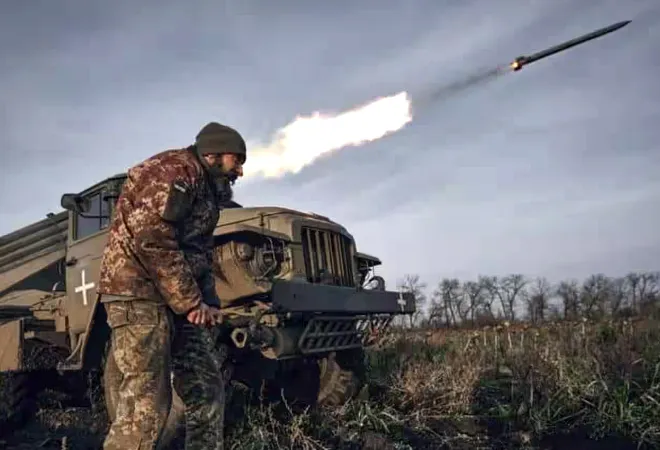-
CENTRES
Progammes & Centres
Location
There are six key takeaways for India from the Russia-Ukraine conflict. The Indian armed services, especially the Indian Army, has its task cut out.

Critical capabilities such as armour, artillery and technical personnel, such as engineers, will still matter, and they are not replaceable by cyber, space and other non-kinetic information-related capabilities.Second, this leads us to a corollary and related variable – attritional warfare still matters, making armies and land power vital to a nation’s security and defence, including India’s. Mass is integral to war by attrition. It is a key means to deter and defeat any invading force. Despite its costs, the lack of military strength in the form of strong ground forces to defend the territory will be a recipe for State collapse. Humans live on land, and wars will be decided on land when push comes to shove. Critical capabilities such as armour, artillery and technical personnel, such as engineers, will still matter, and they are not replaceable by cyber, space and other non-kinetic information-related capabilities. Third, the Russia-Ukraine war has revealed the vulnerability of maritime forces to interdiction and destruction by cheap missiles. As a result, the Russian Navy’s Black Sea fleet has effectively retreated to its bases or been compelled to maintain a safe distance from Ukrainian shore-based missiles. It is not for nothing the Chinese have built a whole range of “carrier killing” shore- and land-based projectiles in the form of Anti-Ship Ballistic Missiles and Anti-Ship Cruise Missiles to keep the US Navy and allied navies surface fleets away from the Chinese mainland. India can also emulate Ukraine and China by building its land-based ballistic and cruise missile forces. Fourth, deep penetration attacks inside enemy territory, employing rotary and fixed-wing aircraft, have proved ineffective in producing a strategic effect in the military contest between Russia and Ukraine. Take rotary-wing aircraft such as the Apache, which India operates, and is geared for deep strike missions. They proved far less effective in the second Gulf War of 2003 while facing Iraqi ground-based air defence artillery. If Indian Apaches have any role to play against Pakistan or China, it will most likely be in a reconnaissance role or missions involving close air support for ground forces. Ukrainian forces have used short-range anti-aircraft weapons and small arms fire with lethal effect against Russian fixed-wing and rotary-wing aircraft. On the other hand, the Ukrainians have yet to gain much either, as they have been compelled to use their air assets to support ground forces and preserve combat strength. Consequently, neither side has gained air superiority. India could benefit considerably by developing Counter-Unmanned Aerial Systems, instead of investing heavily in deep-penetration strike capabilities, which are highly vulnerable to adversary interdiction. Supplementing this effort most critically is the necessity for greater synergy, which can significantly augment strategic lethality by making battle networks and components highly integrated and interoperable.
Ukrainian forces have used short-range anti-aircraft weapons and small arms fire with lethal effect against Russian fixed-wing and rotary-wing aircraft. The fifth issue that Indian defence planners must consider is that airborne and amphibious missions are susceptible to lethal targeting by the enemy. The war in Ukraine and empirical evidence from the past prove airborne and amphibious operations are laden with high risk, and are resource intensive. For example, Russian airborne forces incurred heavy losses in trying to seize Hostomel airport in the early stages of Moscow’s invasion of Ukraine. Amphibious and airborne forces might not be relics of the past, but they must be used in selective and specific missions. Acquiring capabilities that increase the survivability and lethality of Indian forces should be the core aim of Indian military planners.Finally, Artificial Intelligence (AI) has already played an important role in the Ukraine conflict and will do so in future wars. The application has been transformational on the battlefield in Ukraine. Ukrainian forces have employed AI with devastating impact by deploying or embedding software engineers with combat units on the battlefront in Bakhmut. The engineers have precisely adjusted functions of algorithms to augment their target-acquisition capabilities, enabling commanders to accurately locate Russian forces for destruction. This AI application is evolving as AI is dependent on constant data inputs. The data acquired from battle-damage assessments after a kinetic attack is fed into a digital network, strengthening the predictive model. Ukrainians have used a combination of sensor data derived from satellite intelligence and AI instruments to execute precise strikes against Russian forces. AI has also augmented the survivability of Ukrainian forces against Russian attacks. The Indian armed services, especially the Indian Army, has its task cut out. It must invest in armour, missile and artillery capabilities and apply emerging technologies not as substitutes but as enablers of these firepower-intensive capabilities.
The views expressed above belong to the author(s). ORF research and analyses now available on Telegram! Click here to access our curated content — blogs, longforms and interviews.

Professor Harsh V. Pant is Vice President – Studies and Foreign Policy at Observer Research Foundation, New Delhi. He is a Professor of International Relations ...
Read More +
Kartik Bommakanti is a Senior Fellow with the Strategic Studies Programme. Kartik specialises in space military issues and his research is primarily centred on the ...
Read More +